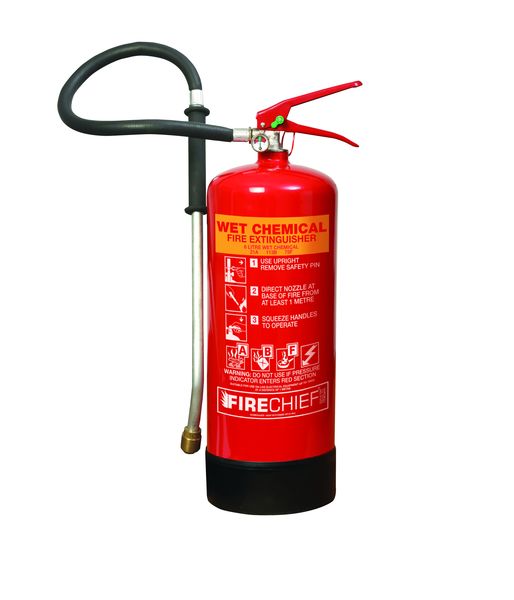-

Seton AFFF Fire Extinguisher
From £33.99 To £53.83Supplied in: Single -

Seton ABC Powder Fire Extinguisher
From £16.69 To £43.69Supplied in: Single -

Economy Powder Fire Extinguishers
£17.69Supplied in: Single -

Wet Chemical Fire Extinguishers With Wall Mounting
From £75.99 To £106.19Supplied in: Single kit -
Promotion

Compact Foam Fire Extinguisher
£26.82
£24.77
Supplied in: Single -

Kitchen/Canteen Fire Bundle Kit
£91.39Supplied in: Single kit
Kitchen Fire Extinguishers
Easy To Use Kitchen Fire Extinguishers - Fast Delivery
Between April 2019 and March 2020, the fire service was called out to 557,229 fires in English homes, almost half of which were caused by cooking appliances. Would you know what to do in the event of a fire? Are you confident that you could take the right actions to keep your family safe?
Having a kitchen fire extinguisher available nearby is a great way to help mitigate the spread of a fire and the associated damage and risks of injury. At Seton, we stock a comprehensive range of different types of fire extinguisher, all designed for the kitchen environment.

What type of extinguisher do you need?

What type of extinguisher do you need?
Also discover:
Fire safety equipmentCo2 fire extinguishersFoam fire extinguishersDry powder fire extinguishersWet chemical fire extinguishersHome fire extinguishersOffice fire extinguishersCar fire extinguishersCaravan fire extinguishersFire extinguishers for petrol
How To Deal With Kitchen Fires
Kitchens are hot zones with many appliances and consumables that can cause a fire. Having a kitchen fire extinguisher at hand can prevent damage, injury and even death.
You can only fight Class K fires – those involving vegetable oils, animal oils and fats – with a cooking oil fire extinguisher. When choosing a fire extinguisher for the kitchen, combine it with other essentials to boost your home fire safety.
Seton’s kitchen fire bundle kit is a good starting point. It contains a compact XRT or wet chemical fire extinguisher that will put out fat, solid and flammable liquid fires. We also included a much-needed fire blanket and fire alarm in this combination-buy. You can even consider a commercial kitchen fire extinguisher for your home setup.
According to government statistics, the fire service was called out to 557,299 fires in English homes between April 2019 andd March 2020, almost half of which were caused by cooking appliances. This means that there was roughly one kitchen fire per 20 households - and those were just the ones that were serious enough to need help. Would you know what to do if faced with one yourself?
Oven fires are common but, thankfully, easy to deal with in most cases. Simply close the oven door and turn the oven off. If the fire doesn’t go out, call the fire service. Don’t assume that the fire is out and leave the room. As stated by the Hampshire fire and rescue service, a total of 89% of kitchen fires actually happen when nobody is the room to take control of a developing danger. Food that has been burning can sometimes catch light again after the initial fire has been put out.
Make sure you know where the master controls are for gas and electricity in your home. If you can’t get close enough to turn the oven off directly, use these.
Tackling cooking oil fires
Cooking oil fires and fat pan fires are very dangerous. If you throw water at them, they can get worse, as well as spitting and injuring you. Wet chemical fire extinguishers should be used to put them out. You should cut off the source of heat and use a Fire Blanket to smother the pan. This will prevent it from igniting again.Wet Chemical Fire Extinguishers are ideal for this job. You can identify this type of extinguisher by the yellow band near the top. Never use a water-based or dry powder extinguisher on this type of fire.
Electrical fires in the kitchen
Water is dangerous around electrical fires because it conducts electricity. This can cause a fire to spread. If one of the electrical appliances in your kitchen catches fire, use a Dry Powder Extinguisher (the type with the blue band) to put it out. Our Economy Powder Fire Extinguishers are great value and ideal for kitchen use.To reduce the risk of this type of fire starting, keep your appliances in good condition and get them serviced in accordance with the manufacturer’s advice. If you use multi-plug extension sockets, choose ones with built-in circuit breakers and never chain them together.
Other types of kitchen fire
For other types of kitchen fire, including fires on the hob that don’t involve oil or grease, a Foam Fire Extinguisher is a good choice. It can be identified by a cream-coloured band. If you want to find the best fire extinguisher for kitchen use, this is a good all-rounder but, if you don’t have a cooking oil fire extinguisher as well, you should limit what you cook because it’s just not worth putting your family at risk.A small kitchen fire extinguisher such as our Compact Foam Fire Extinguisher won’t cost you much and it could make the difference between life and death. Make sure you’re properly equipped; the alternative doesn’t bear thinking about. See our full range of Fire Extinguisher Storage & Accessories for all of your extinguisher display and storage needs.
Take a look at our guide to learn more about the different types of fire extinguishers.
